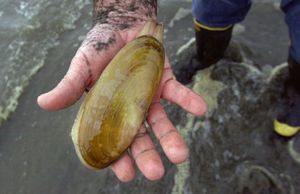Record razor clamming season planned on Washington Coast
SHELLFISHING -- A series of razor clam digs proposed for April and May would cap a season packed with more “beach days” than any time in the past 25 years, the Washington Department of Fish and Wildlife says.
After a nine-day opening that runs through today, state shellfish managers are planning another 24 days of digging on morning low tides at various beaches from April 4 through May 17.
Final approval of those digs depends on the results of marine toxin tests, which have consistently shown this season that the clams are safe to eat.
“We’ve had a great season so far and we expect it to continue that way in the months ahead,” said Dan Ayres, WDFW coastal shellfish manager. “We have an abundance of clams on most beaches, which makes for some terrific digging opportunities.”
Proposed digging days in April and May, along with the remaining digs in March, are posted on WDFW’s website.
Diggers are required to keep the first 15 clams they dig. Each digger's clams must be kept in a separate container. No digging is allowed on any beach after noon.
Counting the new dates in April and May, Ayres said WDFW plans to provide a total of 286 “beach days” of digging on Washington beaches this season – the highest number since 1989. He defined a “beach day” as one beach open for a single day, so four beaches open for one day counts as four beach days.
Annual razor clam seasons typically end in mid-to-late May, when the clams begin to spawn and are less desirable for eating, Ayres said.
Diggers need a valid 2015-16 fishing license to participate in razor clam digs effective April 1, the beginning of the new license year.
State fishing and hunting licenses are available from dealers as well as online or by phone (866) 246-9453.
Threatened species notice
Wildlife biologists are trying to educate clam diggers to avoid disturbing snowy plovers and streaked horned larks. Both species nest in the soft, dry sand at Leadbetter Point on the Long Beach Peninsula and on a section of Twin Harbors beach.
The snowy plover is a small bird with gray wings and a white breast. The lark is a small bird with a pale yellow breast and brown back. Male larks have a black mask, breast band and “horns.” Both species are listed as “threatened” under the federal Endangered Species Act.
“Nesting season for snowy plovers and streaked horned larks begins in early April, coinciding with the scheduled clam digs,” said Anthony Novack, district biologist for WDFW. “Snowy plover nests are difficult to see, so it’s easy to disturb or destroy them without even being aware of it. If an adult is scared off its nest, it leaves the eggs exposed to predators like crows and ravens.”
To protect these birds, the department asks that clam diggers avoid the dunes and areas of the beach with soft, dry sand. When driving to a clam-digging area, diggers should enter the beach only at designated access points and stay on the hard-packed sand near or below the high tide line, Novack said.
Clam digging dates in May for Copalis and Mocrocks will be announced after harvest from the April digs has been analyzed. Upcoming digs in April and May are scheduled on the following dates, pending favorable marine toxin results:
- April 4, Saturday, 7:23 a.m.; 0.6 feet; Long Beach, Twin Harbors, Mocrocks, Copalis
- April 5, Sunday, 7:57 a.m.; 0.3 feet; Long Beach, Twin Harbors, Mocrocks, Copalis
- April 6, Monday, 8:32 a.m.; 0.3 feet; Long Beach, Twin Harbors
- April 7, Tuesday, 9:09 a.m.; 0.1 feet; Long Beach, Twin Harbors
- April 8, Wednesday, 9:48 a.m.; 0.1 feet; Long Beach, Twin Harbors
- April 9, Thursday, 10:32 a.m.; 0.2 feet; Long Beach, Twin Harbors
- April 10, Friday, 11:23 a.m.; 0.4 feet; Long Beach, Twin Harbors
- April 17, Friday, 6:03 a.m.; -0.2 feet; Long Beach, Twin Harbors, Mocrocks
- April 18, Saturday, 6:52 a.m.; -0.9 feet; Long Beach, Twin Harbors, Mocrocks, Copalis
- April 19, Sunday, 7:39 a.m.; -1.3 feet; Long Beach, Twin Harbors, Mocrocks, Copalis
- April 20, Monday, 8:25 a.m.; -1.5 feet; Long Beach, Twin Harbors
- April 21, Tuesday, 9:11 a.m.; -1.3 feet; Long Beach, Twin Harbors
- April 22, Wednesday, 9:57 a.m.; -0.9 feet; Long Beach, Twin Harbors
- April 23, Thursday, 10:46 a.m.; -0.4 feet; Long Beach, Twin Harbors
- April 24, Friday, 11:38 a.m.; 0.2 feet; Long Beach, Twin Harbors
- May 2, Saturday, 6:23 a.m., 0.2 feet; Long Beach, Twin Harbors
- May 3, Sunday, 6:59 a.m., -0.3 feet; Long Beach, Twin Harbors
- May 7, Thursday, 9:30 a.m., -0.8 feet; Long Beach, Twin Harbors
- May 8, Friday, 10:14 a.m., -0.7 feet; Long Beach, Twin Harbors
- May 9, Saturday, 11:03 a.m., -0.4 feet; Long Beach, Twin Harbors
- May 10, Sunday, 11:58 a.m., -0.1 feet; Long Beach, Twin Harbors
- May 15, Friday, 4:58 a.m., -0.2 feet; Long Beach, Twin Harbors
- May 16, Saturday, 5:50 a.m., -0.9 feet; Long Beach, Twin Harbors
- May 17, Sunday, 6:38 a.m., -1.5 feet; Long Beach, Twin Harbors

